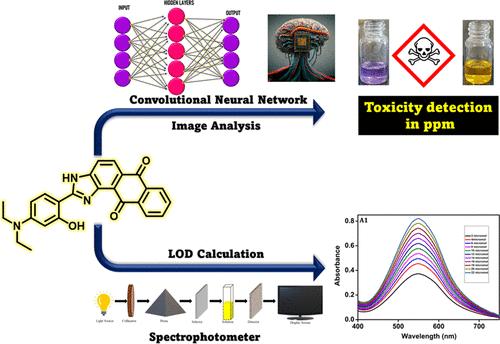Environmentally Sustainable Detection of Arsenic using Convolutional Neural Networks and Imidazole-Based Organic Probes: Application in Food Samples and Arsenic Album
IF 3.7
3区 医学
Q2 CHEMISTRY, MEDICINAL
引用次数: 0
Abstract
Arsenic contamination poses a significant health risk, particularly when it infiltrates water supplies. While current detection methods offer precise analysis, they often involve complex instrumentation not suitable for field use. This study presents a novel approach by developing two probes, A1 and A2, based on 4-diethylaminosalicyladehyde, 2-hydroxy-1-naphthaldehyde, and 1,2-diaminoanthraquinone. These probes are highly sensitive and selective for detecting arsenite (As(III)) and arsenate (As(V)) in water, food samples, and homeopathic medicine with limits of detection in the nanomolar range. To elaborate our contribution to on-site arsenic detection, we introduce a convolutional neural network-based image recognition system. This system interprets images of the probes’ colorimetric response, effectively categorizing different ranges of arsenic concentrations in parts per million (ppm). Our approach offers a real-time, cost-effective, and user-friendly solution for arsenic detection, extending its applicability from scientific laboratories to in-field conditions and even household monitoring. The findings fill critical research gaps in real-time detection methods, potentially revolutionizing the way we monitor environmental contaminants like arsenic.

利用卷积神经网络和咪唑类有机探针对砷进行环境可持续检测:在食品样本和砷相册中的应用
砷污染对健康构成重大威胁,尤其是当砷渗入供水系统时。虽然目前的检测方法可以提供精确的分析,但往往涉及复杂的仪器,不适合现场使用。本研究提出了一种新方法,即基于 4-二乙氨基水杨醛、2-羟基-1-萘甲醛和 1,2-二氨基蒽醌开发两种探针 A1 和 A2。这些探针对检测水、食品样品和顺势疗法药物中的亚砷酸盐(As(III))和砷酸盐(As(V))具有高度灵敏性和选择性,检测限在纳摩尔范围内。为了阐述我们对现场砷检测的贡献,我们引入了基于卷积神经网络的图像识别系统。该系统能解释探针的比色反应图像,有效地对砷浓度的不同范围进行分类,单位为百万分之一(ppm)。我们的方法为砷检测提供了一种实时、经济、用户友好的解决方案,将其适用范围从科学实验室扩展到现场条件甚至家庭监测。这些发现填补了实时检测方法方面的重要研究空白,有可能彻底改变我们监测砷等环境污染物的方式。
本文章由计算机程序翻译,如有差异,请以英文原文为准。
求助全文
约1分钟内获得全文
求助全文
来源期刊
CiteScore
7.90
自引率
7.30%
发文量
215
审稿时长
3.5 months
期刊介绍:
Chemical Research in Toxicology publishes Articles, Rapid Reports, Chemical Profiles, Reviews, Perspectives, Letters to the Editor, and ToxWatch on a wide range of topics in Toxicology that inform a chemical and molecular understanding and capacity to predict biological outcomes on the basis of structures and processes. The overarching goal of activities reported in the Journal are to provide knowledge and innovative approaches needed to promote intelligent solutions for human safety and ecosystem preservation. The journal emphasizes insight concerning mechanisms of toxicity over phenomenological observations. It upholds rigorous chemical, physical and mathematical standards for characterization and application of modern techniques.

 求助内容:
求助内容: 应助结果提醒方式:
应助结果提醒方式:


